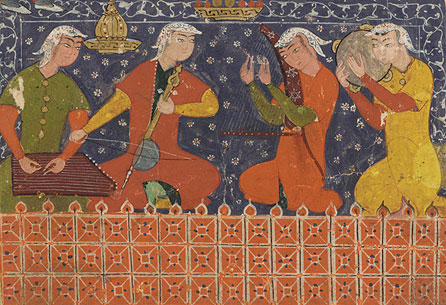

The fiddles performed in this concert are Chinese two-stringed instruments called erhu, banhu, and zhonghu. This kind of spike-fiddle was brought to China in the thirteenth century from nomadic tribes to the northwest. Although the galleries own no artwork depicting the Chinese version, this same instrument traveled west along the Silk Road to become the rabab of Arab music, the kamanche of Persian music, and the kemençe of Turkish music. The sixteenth-century painting above shows musicians entertaining the fifth-century Persian king Bahram Gur and a princess in one of his seven legendary pavilions.
Bahram Gur and the Princess in the Red Pavilion (detail), from the Khamsa (Quintet) by Nizami. Iran, Astarabad, Safavid period, ca. 1560. Opaque watercolor, ink and gold on paper. Purchase–Smithsonian Unrestricted Trust Funds, Smithsonian Collections Acquisition Program, and Dr. Arthur M. Sackler, S1986.283